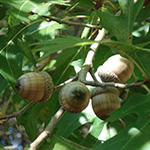Plant of the Month
Every month we feature a plant that we think deserves a spotlight in Florida-Friendly gardening.
2026
January

Silver buttonwood (Conocarpus erectus) is a low-branching, shrubby tree that generally grows 15 to 20 feet tall. Its high salt tolerance and ability to thrive in sandy soil makes it ideal for coastal landscapes. Silky hairs cover the surface of its leaves, giving the tree a silvery shimmer. Silver buttonwood grows well in South Florida and can be planted in USDA Hardiness Zones 10B through 11. It can handle various types of well-drained soil and is quite tolerant of drought conditions. It’s a perfect evergreen to plant along street edges or sidewalks, as it adapts well to urban environments.
2025
December
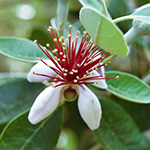
Pineapple guava (Acca sellowiana) is a favorite for its attractive silvery foliage, unusual flowers and edible fruits. Also known as feijoa, this shrub is well-suited for coastal gardens because it tolerates salt spray. Native to South America, pineapple guava can be grown throughout Florida and is easily pruned to form a dense hedge, shrub or trained into a small tree with a single trunk. Some people liken the small, egg-shaped fruits’ flavor to that of guava, while others say that it’s closer to a minty pineapple.
November
Shumard oak (Quercus shumardii) is a native tree that offers shade in the summer and a burst of rich color in fall. It’s ideal for urban landscapes, since it thrives in a range of growing conditions. But Shumard oaks are most prized for their dark green leaves that turn a brilliant red or orange before dropping for the winter. Its large acorns attract a variety of wildlife, too. Hardy in zones 5b-9b, Shumard oak can grow up to 80 feet tall, with a canopy 40-50 feet wide, making it an excellent shade tree.
October
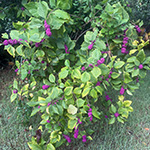
Beautyberry (Callicarpa americana) can be found growing in hammocks and woodland areas. If you’re looking for a dazzling plant to attract birds to your yard, look no further than beautyberry. This sprawling native shrub has striking, bright purple fruits that add jubilant color to the landscape. Beautyberry can be planted year-round in zones 8a to 10b and is drought tolerant once established.
September

Jaboticaba (Plinia cauliflora) is a tropical fruit tree with fragrant, otherworldly flowers and grape-like fruits that cling directly to the bark. It’s slow to grow, but becomes quite productive once mature. This Brazilian native will grow up to 20 feet. Suited for zones 10a-11b only, jaboticaba does best in full sun or partial shade with moist, well-drained soil.
August
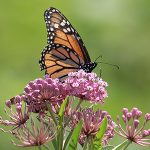
Native milkweeds make a wonderful addition to butterfly gardens. They serve as food and provide habitat, creating a safe haven on the monarch migration route. These flowering plants also provide nectar for other pollinators and play an important role in the local ecosystem. There are currently six commercially available species of native milkweeds in Florida, which can be planted for both conservation and their beauty.
July
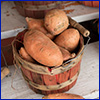
Sweet potatoes (Ipomoea batatas) are known for their colorful and tasty tubers. The flesh is generally orange but certain cultivars come in white, yellow or purple. They’re an excellent source of calcium, potassium and vitamins A and C. A warm-season crop in Florida, sweet potato thrives in hardiness zones 9a through 11b. Sweet potatoes can be planted in the spring in a sunny, well-drained location.
June

Pawpaw is a small tree with big history. This native tree grows best in North Florida and its sweet fruits have fed wildlife and early Americans alike. Common pawpaw (Asimina triloba) is deciduous and can provide a showy display of yellow leaves that eventually fall in autumn. Hardy in zones 5A through 8B, pawpaw does best in rich, moist and slightly acidic soil. While it will tolerate some shade, plant your tree in full sun for a denser canopy.
May
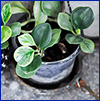
Florida peperomia (Peperomia obtusifolia), also called baby rubber plant, is perfect for filling shaded areas as a groundcover or atop a shelf as a houseplant. This native peperomia can be grown outdoors in USDA Hardiness Zones 10 through 11 in partial to deep shade. It also makes a great indoor plant, with an attractive tendency to cascade over the sides of containers. Florida peperomia prefers rich, well-drained soil.
April
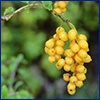
Golden dewdrop (Duranta erecta) is an evergreen shrub or small tree with enticing blue-purple flowers that attract a host of pollinators. Its common name references the showy yellow fruits that cascade from its weeping branches. It can be grown in USDA Hardiness Zones 9a through 11b. This versatile plant can be used as a screen, as a container plant and can even be grown indoors next to a sunny window.
March
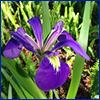
Iris — These showy flowering perennials can be found throughout Florida. Many species grow in wet conditions, making them ideal plants for a bog garden. Their attractive flowers and upright foliage make for an elegant addition to the Florida landscape.
February
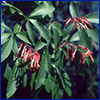
Red Buckeye – Native to the southeastern US, red buckeye is a small deciduous tree that attracts pollinators to its tubular bright red flowers in the spring. Suitable for growing in zones 6A through 9A, red buckeye thrives in partial shade in well-drained to occasionally wet soil.
January
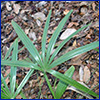
Needle Palm – This native palm can work well in home landscapes throughout Florida. Its lustrous, evergreen leaves make it a great accent plant beneath new or established trees. Appreciated for its cold hardiness, needle palm’s additional ability to thrive in heat and drought make it a versatile plant. The palm can be grown in zones 6b to 10b; it prefers partial shade, with rich, moist well-drained soil, but can be grown in full sun.
(Photo: Chris Evans, University of Illinois, Bugwood.org)
2024
December
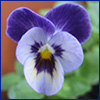
Pansies – Charming cold-tolerant annuals, pansies come in an array of colors, including some hybrids with unusual flower colors or improved heat tolerance. They can be planted throughout Florida in November and December, and thrive in well-drained soil with a little shade.
November
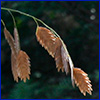
Native Grasses – Florida’s native ornamental grasses not only work well in our climate, they’re also an excellent option for filling up large areas with vegetation. Most species require little maintenance, and some tolerate flooding or provide ecosystem services such as erosion control.
October
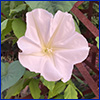
Moonflower – If you want to add some mystery and nighttime ambiance to your garden, consider moonflower, which produces white blossoms that only present themselves during the night. A member of the morning glory family, moonflower is suitable to grow in USDA Zones 11-9B and does best in full sun or partial shade with moist, well-drained soils. As a low-maintenance plant, moonflower offers a unique, expansive vine with no serious pest or disease problems.
September
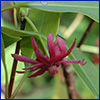
Florida Anise – This native shrub is low-maintenance and sports showy blossoms. Florida anise (Illicium floridanum) works well as a hedge or barrier plant, producing dense foliage to create privacy in place of a fence. Perfect for a woodland setting, this less-common evergreen is well adapted to Florida conditions and rarely experiences disease or pest problems. It’s well suited for sun or shade, making it a versatile option for your yard.
August
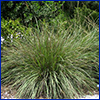
Fakahatchee Grass – Add a touch of native Florida to your landscape with this ornamental grass. Fakahatchee grass (Tripsacum dactyloides) has tall, green, grass-like foliage rising upright to form large clumps—there is also a dwarf cultivar if you are limited by space constraints. For those who like the plants in their landscape to benefit wildlife, Fakahatchee grass is the larval food plant for the Byssus skipper butterfly.
July

Mango – Native to South Asia, mango trees grow best in hardiness zones 10B through 11. An attractive tree with a rounded canopy, mango can grow very large, so it’s best for gardeners with ample space. Plant in full sun and prepare for a little maintenance — mango trees will need occasional pruning, fertilization, and treatment for pests. Depending upon the variety, fruit may be harvested from May through August, so you can enjoy this sweet treat all summer long.
June

Coral Honeysuckle – Native coral honeysuckle (Lonicera sempervirens) grows all over Florida, USDA Hardiness Zones 4 to 10. This vine is best known for its bright red, tubular flowers. Clusters of blooms emerge on new growth in spring and summer. The flowers attract hummingbirds and butterflies for months before maturing into berries.
May

Hibiscus – Evoking beachside paradises and far-flung vacations, hibiscus has flowers that come in a rainbow of colors. Tropical hibiscus (Hibiscus rosa-sinensis) is what’s commonly seen in garden centers and landscapes. However, there are about 35 species of native hibiscus, also called rosemallows, in the United States. Read more about the native and introduced hibiscuses that dial up the drama and bring a touch of the tropics to Florida landscapes.
April
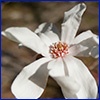
Star Magnolia – Star magnolia is slow growing, but the patient gardener is rewarded with excellent pest and disease resistance coupled with a spectacular show of spring blooms. Consider using it as a patio plant, a small specimen tree, or as an accent shrub. This magnolia prefers locations in full sun with rich, porous, and slightly acidic soil. Star magnolia can be planted in USDA Hardiness Zones 5A through 8B.
March
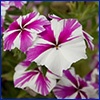
Phlox – A favorite of both pollinators and gardeners, phlox are no longer common in nurseries, but still worth adding to your garden. There are three main varieties: annual phlox, garden phlox, and creeping phlox. Annual and creeping phlox are native to North America, while garden phlox is native to the Eastern US. Phlox thrives in North Florida and can grow as far south as zone 10.
February
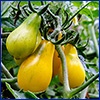
Trusty Tomatoes – They’re one of the most popular edible plants to grow, but tomatoes tend to fall prey to a host of insect and disease problems. As a result, Florida gardeners are always on the hunt for trusty tomato varieties that they can count on to thrive in our climate and survive any attackers. We have a few tomato cultivars that are especially resilient.
January

Arugula – Arugula (aka roquette or rocket) is a leafy green vegetable native to the Mediterranean. The edible leaves have a distinctive sharp, spicy flavor similar to mustard greens. Choose a planting location in full sun with well-drained and rich soil.
2023
December
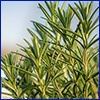
Rosemary – Native to the Mediterranean region, rosemary is a member of the mint family. This herb is often recommended to budding gardeners since it is easy to grow, drought tolerant, and relatively resistant to pests and diseases. This Florida-Friendly plant will thrive year-round, although it may need to be protected from freezes in colder areas of the state.
November
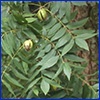
Pecan – Native to North America, Carya illinoensis is massive in stature and can be an outstanding shade tree. Pecan trees are recommended for zones 5B through 9A in landscapes that are large enough to accommodate their size. Although pecan is not a low-maintenance tree, the reward of delicious nuts is enough to convince many gardeners to add it to their landscape.
October

Coral Bean – A native plant that can add interest to the landscape from spring through fall, coral bean has vibrant red flowers that attract hummingbirds. The flowers are followed by black seed pods that crack open to reveal striking crimson seeds. Plant in zones 8 through 11, but take care with site choice; the seeds are poisonous.
September

Yaupon Holly – Add wildlife interest and winter color to your yard with yaupon holly, one of the most durable and adaptable of the small-leaved evergreen hollies for Florida landscapes. Best suited for zones 7A through 9B, yaupon hollies should be planted in a spot where they’ll receive full or partial sun. They are both drought and salt tolerant, meaning this plant can find a home in a variety of landscapes.
August

Live Oak – An iconic Southern tree, Quercus virginiana is a massive oak that can live for centuries when grown under the right conditions. Live oaks are an excellent choice for homeowners who are searching for sturdy, wind-resistant trees. If you’ve got the room, live oaks can be planted in zones 7B through 10B.
July
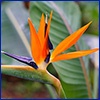
Bird of Paradise – Bird of paradise is a striking evergreen plant with blue-green foliage and showy orange and blue blooms that resemble a bird in flight. Its drought tolerance and pest resistance make it a favorite low-maintenance tropical plant. Strelitzia reginae thrives in USDA Hardiness Zones 10 through 11, although it can survive further north with frost protection.
June
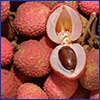
Lychee – Originally from southern China, Litchi chinensis is a subtropical fruit tree. This attractive tree produces fruit that turn bright red when ripe and reveal translucent white flesh with a delicate flavor. New leaves emerge bronze red and eventually turn a glossy green. Best suited for zones 10A-11, lychee thrives in well-drained acidic soil.
May
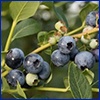
Blueberries – A favorite summer treat, blueberries are an important commercial crop in Florida. Luckily, they thrive in home gardens too. Our winters aren’t cold enough for northern blueberry varieties, so UF/IFAS developed low-chill cultivars that can grow here. Rabbiteye blueberries are typically grown in North and Central Florida, while southern highbush is best suited to locations in Central Florida (zone 9a).
April
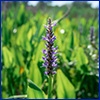
Pickerel Weed – This aquatic native plant is found throughout Florida. A flowering perennial usually found in shallow wetland areas or around the edges of lakes and ponds, pickerel weed has spikes of purple-blue flowers that appear in spring and continue through the summer into fall. A water garden winner, pickerel weed serves as food and habit for a variety of wildlife.
March
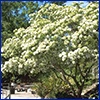
Fringetree – Also commonly called Grancy Greybeard and old man’s beard, fringetree is a small deciduous tree that bursts into bloom in the spring. The flowers are composed of narrow, ribbon-like petals that are snowy white. In fact, the fringetree’s botanical name means “snow flower.” This small tree grows well in North and Central Florida.
February

Golden Dewdrop – This evergreen shrub or small tree makes an attractive backdrop or privacy barrier. Its common name references the showy yellow fruits that cascade from the plant in the summer, but it offers flowers as well. Golden dewdrop grows to a maximum height of eight to 15 feet and is hardy in USDA zones 9B through 11.
January
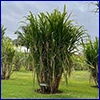
Sugarcane – With foodscapes increasing in popularity, one way you can add an attractive edible to your landscape is by planting sugarcane. This perennial grass from the genus Saccharum ranges in color from green to red to purple. There are different varieties for various intended uses; some are bred for chewing, while others are grown for crystalizing, or for making syrup.
2022
December

Red Cedar – Red cedar is a Florida native evergreen that adds year-round color and texture to your landscape. This tree is highly tolerant of both drought and salt spray, making it an excellent choice for a variety of landscapes. Its pleasing form makes red cedar also popular as a cut or living Christmas tree.
November

Greens – Rich in vitamins A, C, E, and K, greens are easy to grow and very nutritious. They’re also a good source of calcium, potassium, folate, and iron. This group of plants includes spinach, collards, kale, mustard, and turnip greens. Generally considered cool-season vegetables, the time to plant these in Florida is August through February.
October

Bat Flower – With ghostly bracts that look like wings, the bat flower is a unique addition to any home gardener’s collection. With a little extra care, this conversation starter can grow very well in Florida.
September

Carrots – A healthy vegetable that’s easy to grow and doesn’t require a lot of room, carrots are fun to grow, especially with children. The most important thing about planting root vegetables is the soil; it should be loose and free of rocks or roots. Carrots can be planted August to March in North and Central Florida and from September to March in South Florida.
August

Crinums – Crinum lilies are a hallmark of the Southern landscape and have been cherished and cultivated by Florida gardeners for years. Several species of Crinum and dozens of varieties allow you to find the right look for your landscape, with plants ranging in height from 13 inches to 6 feet tall depending on the species.
July

Papaya – Papaya is a tropical tree-like plant native to Central America. The ripe fruit is soft, juicy, and sweet, like a mango or melon. Commercially, papaya are usually grown in South Florida. With care, however, gardeners throughout Florida can enjoy papayas in their home landscape, too.
June

Necklace Pod – A charming choice for pollinator-friendly landscapes, this native shrub features graceful foliage and bright yellow blooms that attract butterflies all year long. Necklace pod is also a perfect coastal plant — highly salt and drought tolerant. It’s well suited for USDA Hardiness Zones 9b-11.
May

Chayote – A heat-loving, tropical vegetable, chayote is perfect for Florida’s steamy summers. It is closely related to melons and squashes. Chayote vines climb and require support, such as a trellis or an arbor. The fruit have a texture similar to mature zucchini. Chayote can be planted throughout the state.
April

Florida Butterfly Orchid – One of the showiest native species, the Florida butterfly orchid has small flowers colored yellow, copper, green, orange, or bronze. A cluster of these blooms looks like a flutter of tiny, colorful butterflies. It grows as an epiphyte in almost every county in the state. Notably, the orchids can withstand a freeze, making them popular on the northern edge of their range.
March

Coral Honeysuckle – Our native coral honeysuckle features scarlet flowers that bloom for months. And Florida’s wildlife love it, too! The flowers attract hummingbirds and butterflies and then mature into berries that feed songbirds. This low-maintenance vine is a Florida-Friendly alternative to invasive Japanese honeysuckle. Coral honeysuckle (Lonicera sempervirens) grows all over Florida and further north, USDA Hardiness Zones 4 to 10.
February

Edible Ginger – The leafy, grassy foliage of edible ginger adds a tropical backdrop for more colorful plants, but is best known for its underground stems, or rhizomes. This is the part of the plant that produces the “ginger” spice we love. It grows well throughout the state, too, as long as the soil is amended with organic matter. And for gardeners with tree-covered landscapes, ginger is one of the few crops that loves some shade.
January

Chickasaw Plum – One of the first to flower each year and an excellent pollinator resource, this native tree grows quickly and will perform best in full sun, though it can also be planted in dappled shade. Each spring, the trees are covered with clusters of tiny, fragrant, white flowers. Then the small fruits appear, turning from red to yellow as they ripen. The tart plums can be eaten fresh or turned into tasty jelly, and they’re also enjoyed by wildlife.

